Interview with Mike Flahive, Ph.D., Saint Xavier University
Linda Schreiber: I'm on the phone today with Mike Flahive of Saint Xavier University, who co-directs a federally funded projectknown as Project SIMPLE. Good afternoon, Mike.Mike Flahive:Good afternoon, Linda.Linda: Mike, Project SIMPLE's is an acronym for Systematic Implementation of a Modular Progr
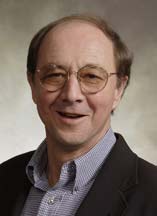
Linda Schreiber: I'm on the phone today with Mike Flahive of Saint Xavier University, who co-directs a federally funded projectknown as Project SIMPLE. Good afternoon, Mike.
Mike Flahive:Good afternoon, Linda.
Linda: Mike, Project SIMPLE's is an acronym for Systematic Implementation of a Modular Progression for Learning Effectivelyit sounds like this project is about interactive learning tools.
Mike:Yes. This project is about instructional technology and what we'd like to think are improved methods of instruction. It was born several years ago, when Mike Chial, who was on the faculty at the University of Wisconsin-Madison (now retired), and I were brainstorming ways we might collaborate between our campuses to enhance the courses we taught and shared interest in.
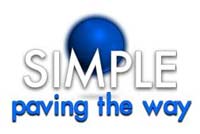
Dr. Chial is an audiologist and has been at the forefront of technological applications in the discipline throughout his career. He has always been very generous with his time and knowledge; the opportunity to work back-and-forth with him was a great opportunity for me. So for a period of 3 or 4 years, we connected about classes and did real-time video back-and-forth in a professional issues course. He and I also each teach counseling, and we shared activities, both in person and electronically.
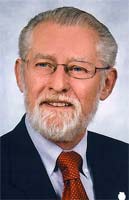
Mike:The tools were developed through the efforts of the Division of Instructional Technology at Madisona group of very gifted people. And it was funded by a grant to support computer-based instructional materials from the Fund for Improvement of Postsecondary Education (FIPSE), U.S. Department of Education.
Linda:So Project SIMPLE is a collaborative effort among your two universities (Saint Xavier University and the University of Wisconsin-Madison) and content experts like yourselves?
Mike:Neither Dr. Chial nor I are aphasiologists, so we relied on collaborators from other institutions with expertise in aphasia. Major contributors at the outset included Malcolm McNeil, Brooke Hallowell, Barbara Shadden, Lyn Goldberg, Jim Naas, and Mary Jo Germani, who helped us develop the focus and parameters to address. Subsequently, we were joined by Laura Murray and Laura Karcher from Indiana University. Audrey Holland, Regents Professor Emerita from the University of Arizona, also has been a wonderful source of inspiration, feedback, and ideas. A major goal of our project was to build this kind of collaboration across campuses.
Linda:So the topic area is aphasia and it is meant to prepare students in the field of communication sciences and disorders.
Mike:Yes. Our interest from the outset was to organize content in creative ways so that instructors in adult neurogenic disorders of language and speech would be able to enhance their work on their local campuses.
Linda:And the learning tools supplant, not replace instruction on campuses?
Mike:Absolutely! We're providing resources, not trying to tell people how to teach. Rather we think we can provide materials that instructors can use with whole classes, or small groups, or individual instruction in ways that are more effective; because we've gone about the business of collecting lots of samples that havewhat I'd like to thinksome fairly well-organized plans for application of the collected materials.
Linda:Project SIMPLE includes some very high-quality video. How did you gather these videos?
Mike:We quickly learned that there was not an adequate pool of quality video archives anywhere. We identified places we could go to videotape persons with aphasia. With the help of our collaborators, we identified patients who became very important to us. Jim Naas, in Owensboro, KY, had several clients who agreed to come on camera. Judy Vander Woude, and her colleague, Jill Bates, have an aphasia clinic at Calvin College, in MI, and 10 of their patients came on camera. We went to the Triangle Aphasia Project in NC where Maura English Silverman runs stroke support groups in the Cary, Chapel Hill and Raleigh-Durham areas and we were able to collect video there. Leora Cherney of the Rehabilitation Institute of Chicago also was very helpful in securing volunteers from her aphasia support group. We now have a collection of 38 individuals with aphasia who talk about their strokes, their recoveries, the ups and the downs, and the emotional components.
And while we collected that footage, the folks at the UW Division of Instructional Technology developed reusable learning tools that allowed non-destructive manipulation of video footage.
Linda:So give me an example of a learning tool.
Mike:OK. One of the software routines is called Quiz Video with which an instructor can customize video to include a range of test questions (with feedback) to verify student understanding of facts, principles or procedures. So using a 5-minute video of an interview between a speech-language pathologist and a person with aphasia, the instructor could underscore question-asking methods, or content vs. affective clinician responses during an interview.
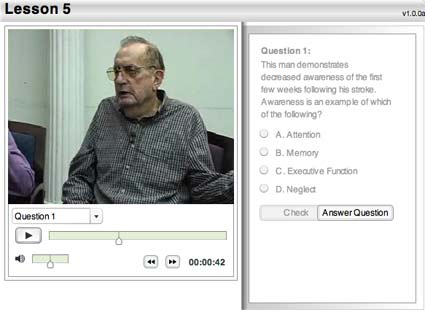
Quiz Video allows the instructor to time-reference those five minutes and to interject screens that include directions or quiz questions. The nice part about the Quiz Video authoring tool is that it doesn't require knowledge of HTML or any other code. So any of us who use computers can create our own sets of question/answer schemes, and employ this tool to build activities that could be presented to students on individual CDs or DVDs, or over the Internet. And the instructor could say, "Tomorrow we're going to be dealing with different question types. I'd like you to go through these activities until you reach 90% success finding various question types." The program can document student performance.
Linda:And that's just one of the tools.
Mike:Yes. Another tool is called Video Annotator. If instructors desire to do so, they can use this tool to annotate on their videos. Once a video is in digital format, instructors can create timed, on-screen text that will appear with the video. Video Annotator differs from traditional captioning in an important way: annotations are not embedded in the video. Thus, one video can have several entirely different annotations. For example, "In this clip, attend to the client's behaviors," and, "In this same clip, attend to the clinician's behaviors." The result is a great savings in storage space for video files.
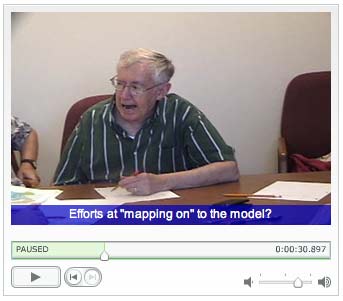
Linda:And that's why you call it Project SIMPLE!
Mike:It's "simple" in several ways.
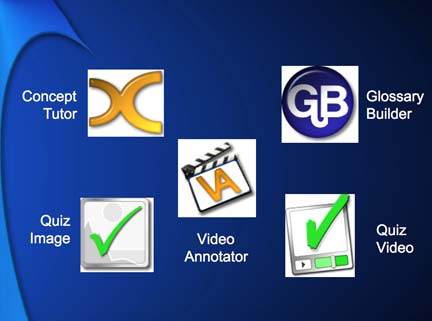
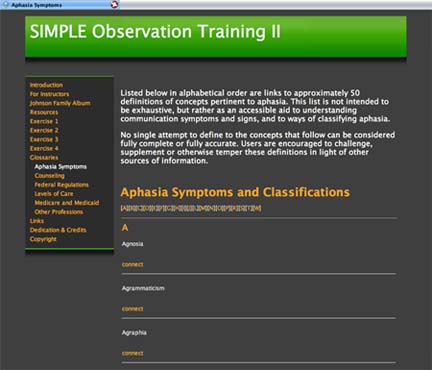
Linda:You also list other tools like Concept Tutor, Glossary Builder, Quiz Image, so instructors have a wealth of tools at the click of a mouse.
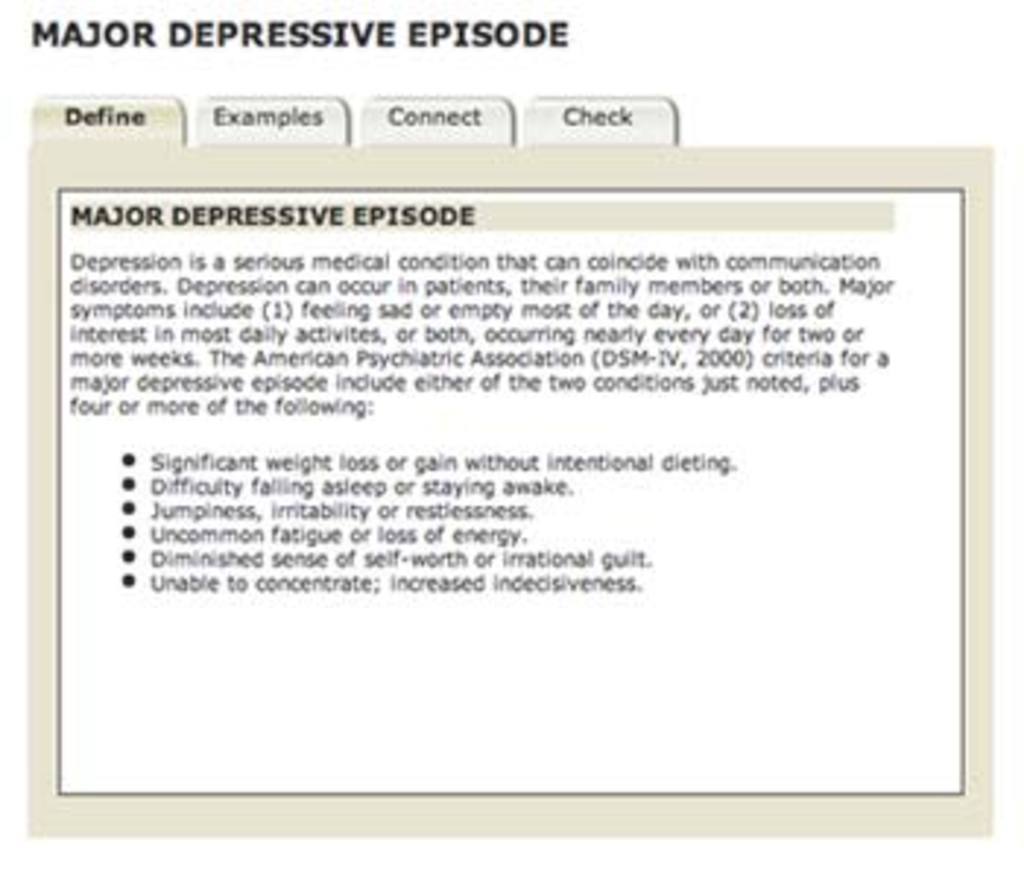
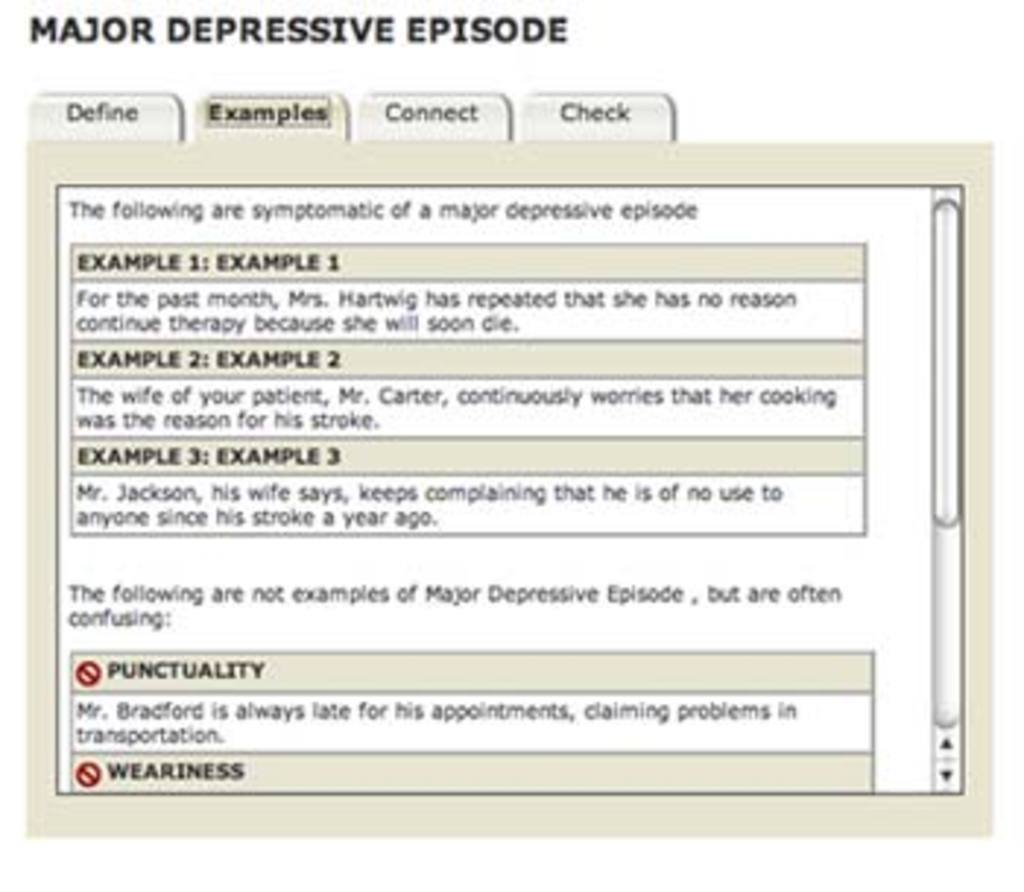
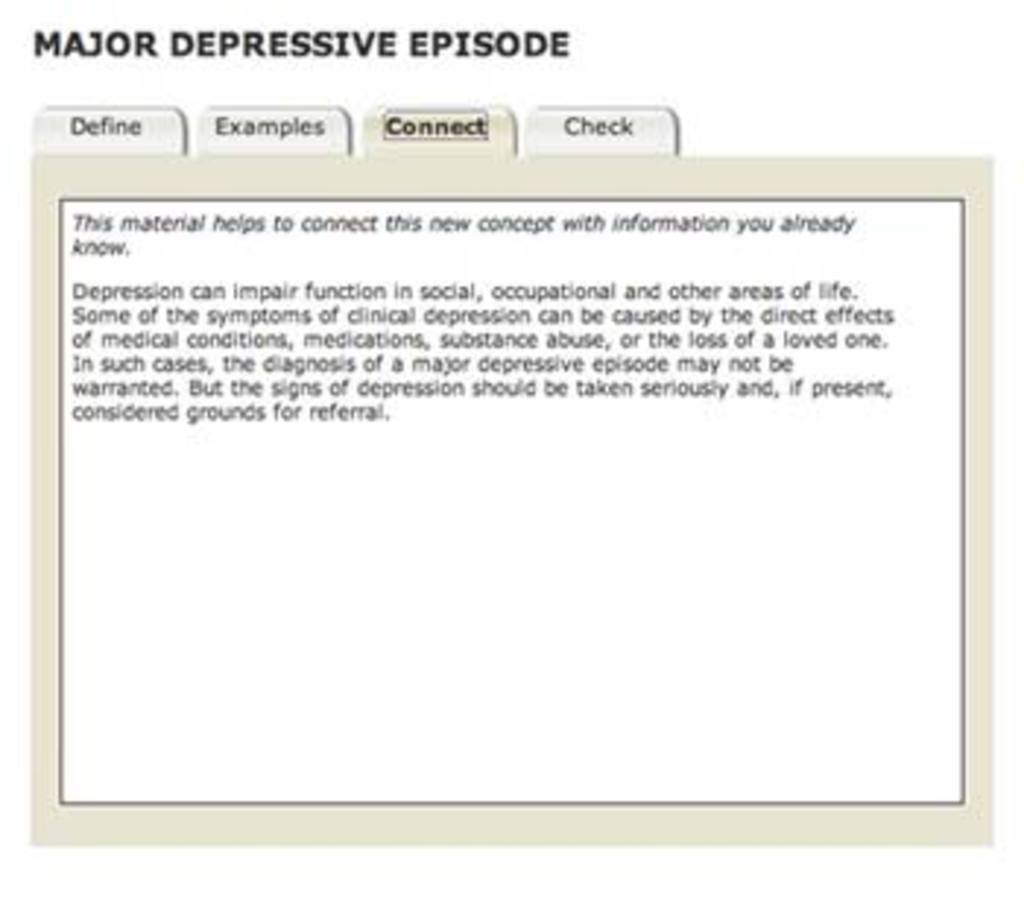
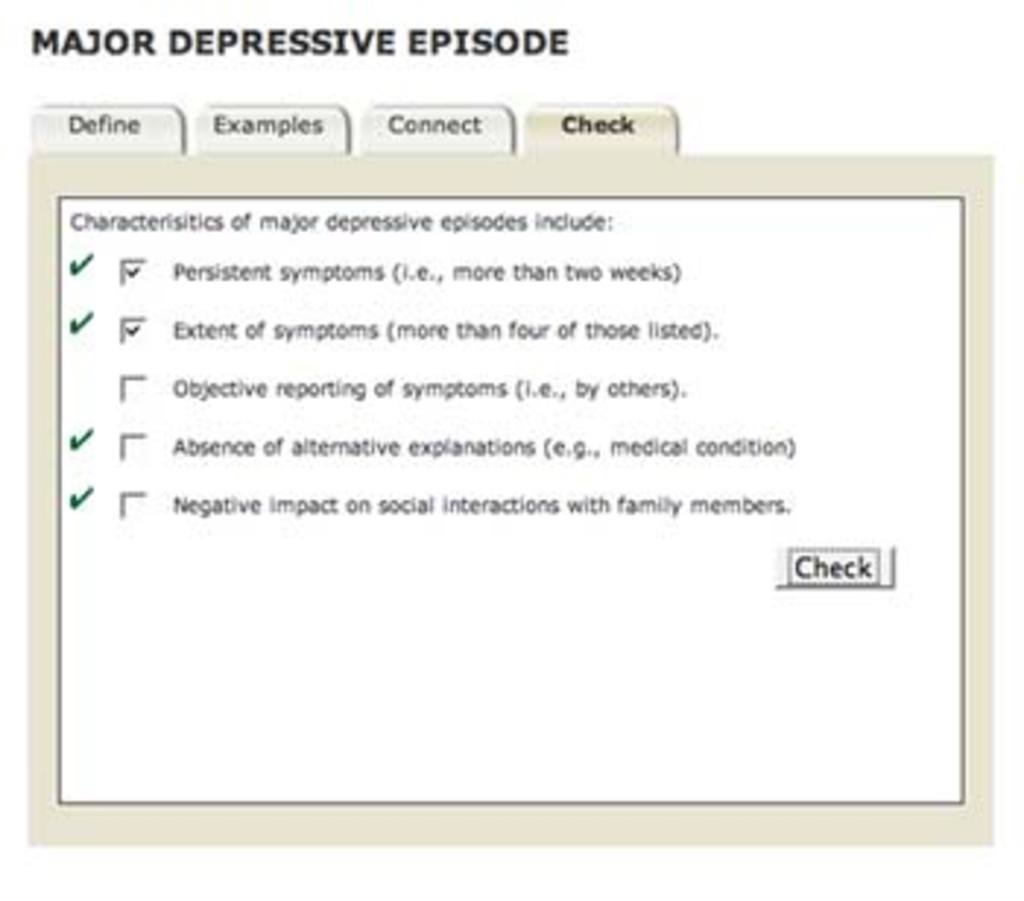
Mike:Yes. There are several tools for instructors to use. However, the real richness of the resource package, to me, lies in the multiplicity of samples. One of the DVDs is about counseling. Since Mike Chial and I teach counseling, there's extensive coverage of that topic. Audrey Holland also teaches counselingshe just published an excellent book on counselingso there's a lot on counseling, including interviews and monologues. We have ten 1-minute samples, ten 5-minute samples, and several other samples of persons with aphasia talking about different things. There's real talk, by real people, about real issues secondary to aphasia.
Linda: Do you address how to use this resource as an instructional tool?
Mike:The final SIMPLE build consists of six DVDs designed to work with web browsers. One DVD, Aphasia Revealed, includes suggestions from five experienced university instructors about how to use various video samples. Most of the DVD exercises are based on students doing things (watch and forget; do and learn). One DVD has the tools instructors can use to go out and build their own stuff.
Linda:And the other DVDs?
Mike:The SIMPLE package includes: Observation Training I, Observation Training II, Aphasia Revealed, Communication Behaviors, Counseling and Reusable Learning Tools.
As noted, two offer training in observational competence. Mike and I have been concerned about the lack of precision and rigor of observational skill development, so we devoted two of the DVDs to observational skills and ways for students to demonstrate competence. We use the samples of individuals with aphasia and have built several exercises to improve observational skills.
Linda:These exercises are certainly needed. How do they work?
Mike:As an example, there's an activity that calls on students to make judgments about the emotional status of a family. Students are directed to "read" the emotions of a family in two different situationsone is the family's emotions upon "Mr. Johnson's" admission to rehab, and then five weeks later the emotion when "Mr. Johnson" is discharged for failure to make progress. We hope to encourage instructors to consider competence in observational skills.
Linda:So if I could summarize, Project SIMPLE is a learning resource tool for instructors, which includes multiple, high-quality videos that can be used for a variety of purposes. It also includes tools for using video for various purposes, including quizzing, demonstrating behaviors, and building knowledge and competence.
Mike:Yes, we expect to complete it by the end of June.
Linda:That's impressive!
Mike:We're also hoping to overhaul our website webfiles.sxu.edu/simple/ to make it more of an exchange forum for instructors who want to share what they've done.
For example, someone might use Video Annotator for instruction in dysfluency or Quiz Video for voice disorders. Someone else might challenge students to build media-rich Concept Tutors ("glossaries on steroids) in the area of dysphagia.
So we expect that the SIMPLE Reusable Learning Tools will be used to focus on other disorders other than aphasia and, in the process, make more effective use of video archives and other media. Several of the learning tools have research applications as well.
Linda:If instructors are interested in getting more information, they can visit the website?
Mike:They can go to the website to learn more about Project SIMPLE webfiles.sxu.edu/simple/
or for more information, email me: [email protected]
or Mike Chial: [email protected]
Linda:Mike, thanks for taking the time to be interviewed this afternoon. Project SIMPLE is a great resource for our students.
